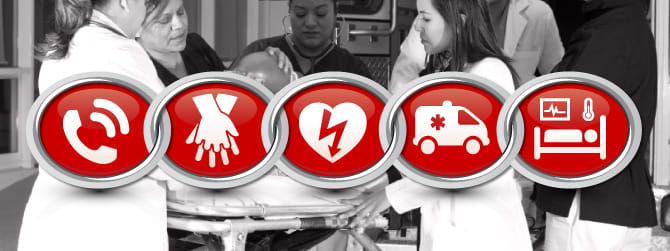Guidelines call for stronger, more coordinated cardiac arrest response
By American Heart Association News

When someone collapses from cardiac arrest, everything that happens after that moment can impact a person’s chances of survival. New resuscitation guidelines lay out instructions for a quick, well-choreographed team approach — from bystanders and 911 dispatchers to emergency response personnel and hospital medical staff.
The new American Heart Association guidelines, published last week in Circulation, call on cities and counties nationwide to strengthen and monitor every step in how they respond to cardiac arrests that occur outside a hospital. The objective is to improve survival, which varies widely across the country, according to the guidelines.
“Your chances of surviving a cardiac arrest shouldn’t depend on which city you live in, or which EMS system responds or which hospital you go to,” said Robert Neumar, M.D., Ph.D., immediate past chair of the AHA’s Emergency Cardiovascular Care Committee. He is also a professor and chair of the University of Michigan Health System’s Department of Emergency Medicine.
More than 326,000 Americans have cardiac arrests outside of a hospital each year. The heart suddenly stops, most often because of a chaotic heart rhythm called ventricular fibrillation, or VF. CPR can manually circulate a small amount of blood, and an automated external defibrillator, or AED, can shock the heart back to a normal rhythm.
Survival rates for cardiac arrest caused by VF are in the single digits in many urban areas. Nationally, the survival rate for bystander-witnessed VF cardiac arrest is 31 percent. When all forms of cardiac arrest are considered, the outcome is more dismal: only 10 percent survive.
Survival rates won’t improve simply by “having faster ambulances or taller hospitals,” said Clifton Callaway, M.D., Ph.D., chair of the AHA’s Emergency Cardiovascular Care Committee and a professor of emergency medicine at the University of Pittsburgh.
What’s needed, the guidelines say, are structured response systems that successfully execute the “chain of survival.” That includes calling 911, giving immediate and effective CPR, defibrillating, providing basic and advanced life support and delivering post-arrest care, such as cooling patients to minimize brain damage and treating heart blockages that led to the cardiac arrest.
Communities nationwide are already seeing the payoff of such coordinated efforts.
In King County, Washington, which includes Seattle, the survival rate for witnessed VF arrest went from the mid-teens in the early 1970s to 55 percent in 2014, according to King County’s Emergency Medical Services Division. The county’s all-time high survival rate of 62 percent happened in 2013.
Mickey Eisenberg, M.D., is the medical director of King County EMS and credits close collaboration within a complex response system.
“There’s no secret sauce,” said Eisenberg, a professor of emergency medicine at the University of Washington. The improvements, he said, have come from training and meticulously measuring and examining performance.
“Our mantra is ‘measure, improve, measure, improve,’” Eisenberg said.
Hoping to learn from King County’s success, Kevin Seaman, M.D., and two other EMS leaders from Howard County, Maryland, in 2010 attended the Resuscitation Academy(link opens in new window), a program from King County EMS and Seattle Medic One.
Using what he learned, the trio the started doing timed CPR drills, put defibrillators in police cars and measured cardiac arrest response and patient results. They trained one small team at a time, and interest grew as EMTs started to save more people, said Seaman, former medical director of the county’s fire department and now executive director of the Maryland Institute for Emergency Medical Services Systems.
In Howard County, the bystander-witnessed VF cardiac arrest survival rate was just 19 percent in 2003. By 2012, the survival rate had risen to 44 percent, which “amazed and empowered” responders, Seaman said.
“[The attitude now is] we expect to get everyone back, and if not, we want to take a hard look at why,” he said.
The new guidelines also emphasize the importance of training the public in CPR. In King County, bystander CPR is given 75 percent of the time before EMS arrives, Eisenberg said. That’s well above the national average of 46 percent.
“Cardiac arrest happens anywhere, anytime,” said Ben Bobrow, M.D., medical director of the Bureau of EMS and Trauma at the Arizona Department of Health Services. “You really need a plan that can take care of people in a variety of places, especially in their homes.”
Arizona has a statewide response system for treating cardiac arrests that emphasizes high-quality CPR, data collection, tracking AED availability, and community awareness about CPR.
“Compression-only CPR was a real game-changer,” said Bobrow, also a professor of emergency medicine at the University of Arizona College of Medicine.
Arizona promoted compression-only CPR to the public through television ads and public service announcements, presenting it as a first aid method rather than a complicated medical skill.
“We’ve had more than a four-fold improvement in cardiac arrest survival [statewide] since we started a decade ago,” Bobrow said.
The survival rate for Arizonans is now about 34 percent, and has reached 56 percent in Mesa, he said.
“King County and Seattle led the way, but it’s feasible for other communities to do this,” Bobrow said.
The AHA guidelines have been updated every five years through a process involving more than 250 international experts from the AHA and six other resuscitation councils that form the International Liaison Committee on Resuscitation.
At an AHA-hosted ILCOR conference in early 2015, experts reached consensus on hundreds of resuscitation topics, based on research published since the 2010 guidelines.
The AHA used that scientific consensus to create the CPR and Emergency Cardiovascular Care guidelines: “how-to” manuals that translate the science into practice. They’re used to train millions of potential rescuers and are integrated into state and local EMS protocols.
But bystanders play the most essential role in saving lives, Callaway said.
“All the chain of survival steps have to work well,” he said, “but they rely on the general public to know what to do.”





